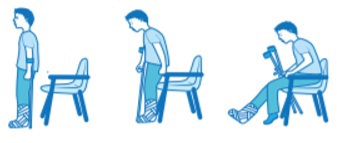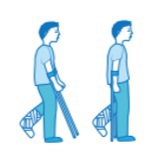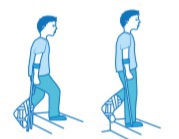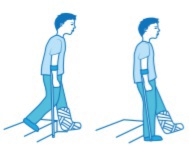You will be measured and the crutches will be adjusted to the correct height for you. Do not change this, as this may make your crutches unsafe to use
Standing up and sitting down
Always keep your hands out of your crutches when trying to stand and sit so you don’t hurt your elbows or shoulders

1. Shuffle your bottom to the front / edge of the chair / bed
2. In one hand hold your crutches in a capital ‘H’ shape
3. Place your other hand on the chair / bed to help push up
4. Push up into standing using your unaffected leg, remembering your affected leg’s weight-bearing status
5. Once you have your balance, place one hand at a time through the loops on the crutches and hold onto the handles so they are pointing forward

6. Separate the crutches so they are slightly in front and put your weight down through the crutches
7. Reverse this for sitting down, ensuring you can feel the surface you are sitting onto, before attempting to sit down
8. Take your hands out of the crutches
9. Reach back with one arm, and lower yourself slowly.
To walk:
1. Place both your crutches slightly in front of, and out to the side of, your feet
2. Push down through your arms and crutches, hop or step your unaffected leg up to the crutches
3. Place the crutches one step ahead, and continue moving forward

4. Do not move your feet in front of your crutches as this can make you unsteady
5. To turn: slowly move around in small hops. Don’t try to swing round or pivot in one movement, as you may become unsteady
Stairs:
- Where possible use the handrail and 1 crutch to complete stairs.
- You can hold your other crutch in your hand or ask someone to carry it for you You can complete the stairs with 2 crutches or on your bottom if you find this easier
- Your crutch/’s always stay with your affected leg
Going up:

1. Lead with your unaffected leg
2. Push down through your crutch/’s and handrail bringing your affected leg up next
3. Lastly bring your crutch/’s up to join
Going down:

1. Place your crutch/’s on the first step down
2. Lower your affected leg down in front of you
3. Push down through your crutch/’s and handrail bringing your unaffected leg to join







